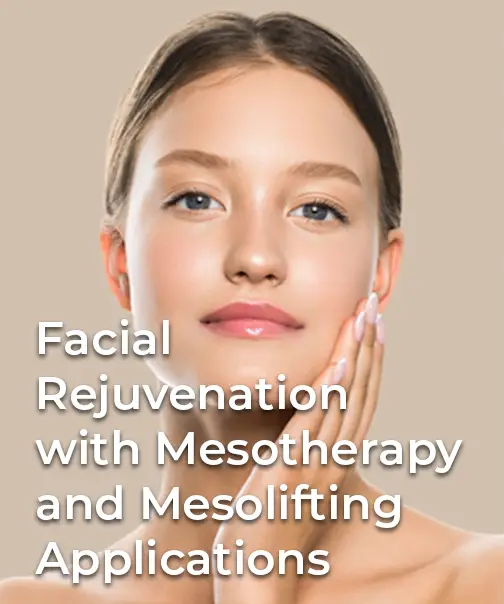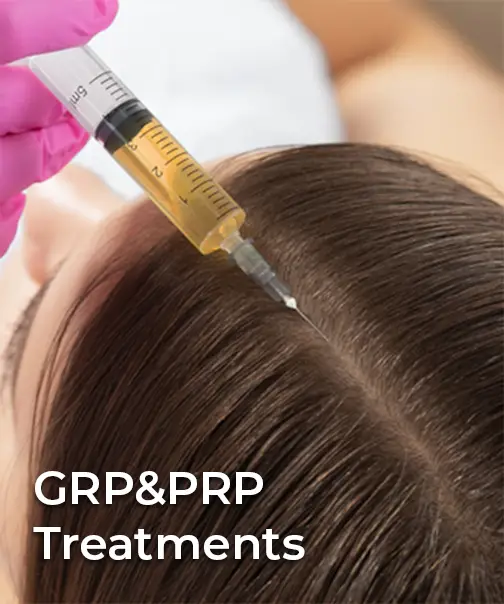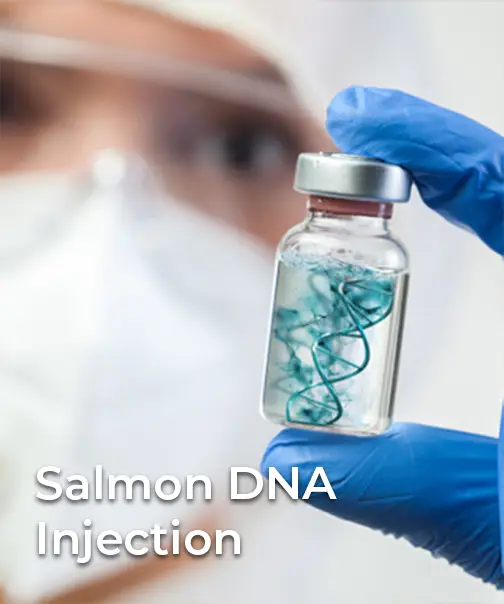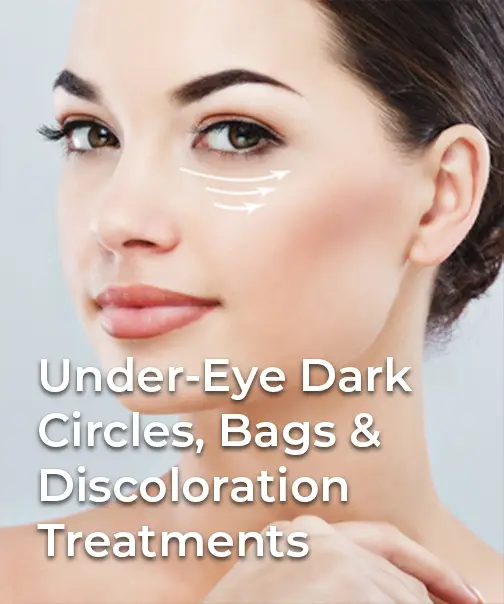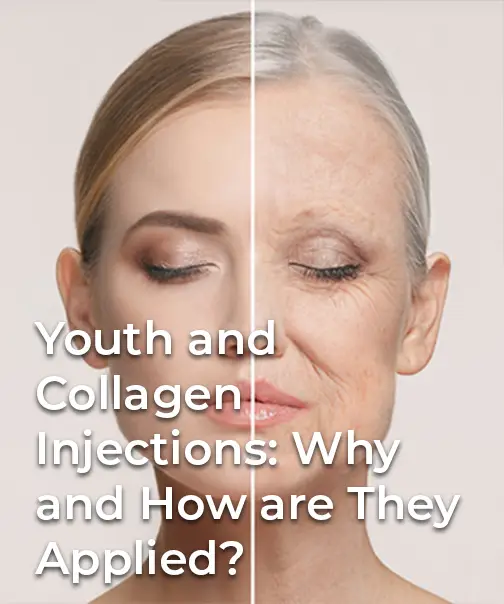GRP&PRP Treatments

Growth Factor Rich Plasma (GRP) is a type of medical treatment called Platelet-Rich Plasma (PRP). PRP treatment involves the use of a special plasma solution derived from the contents of the blood.
GRP is similar to the techniques used in PRP practices. This is the result of a series of scientific research and development studies that began in the 1970s. These studies have shown that platelets in the blood contain growth factors and factors that stimulate cellular healing processes. Over time, applications such as GRP application have been added to PRP youth treatment and advances have been made in the aesthetic field.
What is GRP Treatment?
GRP is among the aesthetic techniques used for rejuvenation. However, GRP can be used for medical purposes in addition to aesthetic purposes. Growth Factor Rich Plasma (GRP) is a special variant of a medical treatment method also known as Platelet-Rich Plasma (PRP). GRP treatment is used in various medical fields. These areas include orthopedics, treatment of sports injuries, dermatology (skin rejuvenation and hair loss treatment), dentistry (implants, periodontal treatment), and more.
GRP injection process begin with the use of the patient’s own blood. Before starting the treatment, a blood sample is taken from him/her. This sample is the source of the plasma solution that will be used for the treatment. It is processed using a centrifuge device. The centrifuge separates the blood into its components. In this step, components such as red blood cells, white blood cells, and platelets are separated.
The plasma solution resulting from the centrifugation process contains platelets and growth factors in a high concentration. These are the main components that make GRP effective. This enriched plasma solution will be used as the active component of the treatment. Depending on the patient’s need for treatment, the enriched GRP solution is injected into the area that has been injured or needs to be treated. GRP injections allow to focus on the specific tissues where the treatment will be applied. This stage aims to promote cellular regeneration and healing.
Is GRP Used for Skin Treatment?
GRP can be used for skin treatment and it is even possible to say that GRP treatment is among the safest treatment options for the skin. The main reason why GRP treatment is among the safest options is that it is obtained from the person’s own blood. Although methods such as mesotherapy in aesthetic dermatology are generally considered safe thanks to the fact that they contain beneficial substances, they are not as guaranteed as methods obtained from the person’s own blood such as GRP and PRP.
GRP treatment has a very important place, especially in the treatment of scars such as scars and burn scars caused by various accidents on the skin. Thanks to the centrifugation process used in the GRP process, the plasma solution, platelets, and growth factors obtained from the person’s own blood play a major role in accelerating and supporting the healing of the wound and burned area.
What is GRP Stem Cell Therapy?
GRP stem cell therapy is a technique generally used in orthopedic diseases. GRP is a method used in the treatment of orthopedic diseases. This treatment method involves the use of a special plasma solution obtained from the patient’s own blood. GRP is particularly used in the treatment of muscle, ligament, tendon, and joint problems. It is especially used in tendon ruptures where self-healing is very difficult and surgical methods are not preferred.
GRP treatment involves a solution rich in growth factors because it contains high concentrations of platelets. These growth factors aim to promote the repair and healing of tissues. GRP therapy is administered by injection into the injured or affected area. This allows the growth factors to be focussed directly on the problem area and can accelerate healing. GRP stem cell therapy is among the procedures performed by athletes for tissue support even if there is no problem. PRP and stem cell applications can also be used in this area, just like GRP treatment.
What Does GRP Do?
The benefits of GRP treatment are mainly as follows:
- Supporting joint health
- Hair loss treatment
- Reduction of muscle spasms
- Reduction of spots on the skin
- Promotion of tissue regeneration
- Supporting bone health
- Reduction of inflammation
- Increasing collagen production
- Healing of broken bones
- Scar removal
- Reduction of bone inflammation
- Treatment of sports injuries
- Acceleration of tissue repair
- Skin regeneration
- Muscle and tendon healing
What is Hair GRP Treatment?
Growth Factor Rich Plasma (GRP) treatment is a method used to treat hair loss problems. This treatment starts with a sample of the patient’s own blood. The blood is separated by centrifugation and a plasma solution containing a high concentration of platelets and growth factors is obtained. This solution is injected into the scalp to help revitalize hair follicles, reduce hair loss, and stimulate hair growth.
GRP hair treatment is generally recognized as an effective option for genetic types of shedding such as androgenetic alopecia. Androgenetic alopecia is one of the most common types of hair loss and occurs due to genetic factors. This disorder is also known as male pattern hair loss. In this hair loss, there is a regional thinning rather than baldness. Therefore, patients turn to easier methods such as GRP rather than hair transplantation methods.
What is the Difference Between GRP and PRP?
The difference between GRP and PRP is more than one. GRP is a special plasma solution that contains more cellular components as well as growth factors and platelets, while PRP is a plasma solution that contains platelets more intensively but less other cellular components. While GRP has a wide range of applications such as skin rejuvenation, hair loss treatment, and treatment of orthopedic disorders, PRP is mostly used as a skin rejuvenation treatment.
What Should Be Considered After the PRP Application?
After PRP practice, the following should be considered:
- Protect the area from sunlight
- Avoidance of extreme heat
- Avoid excessive contact with the area (especially with dirty hands)
- I didn’t wash for a day
- Being sensitive about the products used (not using products such as AHA and BHA acidic and poor quality products)
- Following the doctor’s instructions
- Consulting a doctor in case of pain or complications
The question of what is PRP is often sought for an answer. At Rita Clinic, we offer professional services in very safe treatment options such as GRP and PRP, which are made with one’s own blood. For detailed information about these procedures, and PRP prices in Turkey, you can contact us using our communication channels.
STEM CELL
It is the name of the treatments in which tissue and organ healing is performed by using stem cells in the human body that can self-renew.
IV THERAPY
PRP&MESOTHERAPY
FILLER
Dermal fillers increase the required area’s volume and make it more prominent. With Botox, wrinkles can be removed in areas such as between the two eyebrows, crow’s feet, and lip margins, and a youthful appearance is achieved.
FIBROBLAST
Frequently Asked Questions
What does PRP stand for?
PRP stands for Platelet Rich Plasma. When translated into Turkish, it means Platelet Enriched Plasma. This term refers to the application itself because PRP treatment involves the use of a plasma solution obtained from a sample of the patient’s own blood and containing platelets in a high concentration.


